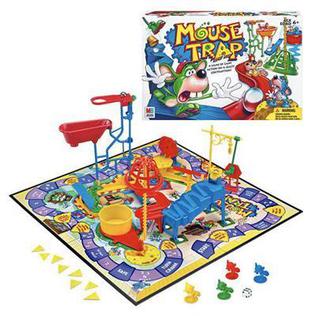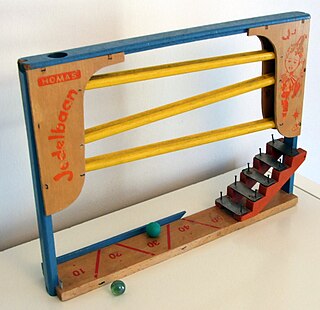
A domino effect or chain reaction is the cumulative effect produced when one event sets off a chain of similar or other events. This term is best known as a mechanical effect and is used as an analogy to a falling row of dominoes. It typically refers to a linked sequence of events where the time between successive events is relatively small.

Reuben Garrett Lucius Goldberg, known best as Rube Goldberg, was an American cartoonist, sculptor, author, engineer, and inventor.

A Rube Goldberg machine, named after American cartoonist Rube Goldberg, is a chain reaction–type machine or contraption intentionally designed to perform a simple task in an indirect and (impractically) overly complicated way. Usually, these machines consist of a series of simple unrelated devices; the action of each triggers the initiation of the next, eventually resulting in achieving a stated goal.

Kinetic art is art from any medium that contains movement perceivable by the viewer or that depends on motion for its effect. Canvas paintings that extend the viewer's perspective of the artwork and incorporate multidimensional movement are the earliest examples of kinetic art. More pertinently speaking, kinetic art is a term that today most often refers to three-dimensional sculptures and figures such as mobiles that move naturally or are machine operated. The moving parts are generally powered by wind, a motor or the observer. Kinetic art encompasses a wide variety of overlapping techniques and styles.

Mouse Trap is a board game first published by Ideal in 1963 for two to four players. It is one of the first mass-produced three-dimensional board games. Players at first cooperate to build a working mouse trap in the style of a Rube Goldberg machine. Then, players turn against each other to trap opponents' mouse-shaped game pieces.

Frederick Rowland Emett OBE, known as Rowland Emett, was an English cartoonist and constructor of whimsical kinetic sculpture.

Chuck Hoberman is an artist, engineer, architect, and inventor of folding toys and structures, most notably the Hoberman sphere.

Robotic art is any artwork that employs some form of robotic or automated technology. There are many branches of robotic art, one of which is robotic installation art, a type of installation art that is programmed to respond to viewer interactions, by means of computers, sensors and actuators. The future behavior of such installations can therefore be altered by input from either the artist or the participant, which differentiates these artworks from other types of kinetic art.
The MIT Museum, founded in 1971, is located at the Massachusetts Institute of Technology in Cambridge, Massachusetts. It hosts collections of holography, technology-related artworks, artificial intelligence, architecture, robotics, maritime history, and the history of MIT. Its holography collection of 1800 pieces is the largest in the world, though only a few selections from it are usually exhibited. As of 2023, works by the kinetic artist Arthur Ganson are the largest long-running displays. There is a regular program of temporary special exhibitions, often on the intersections of art and technology.

Jean Tinguely was a Swiss sculptor best known for his kinetic art sculptural machines that extended the Dada tradition into the later part of the 20th century. Tinguely's art satirized automation and the technological overproduction of material goods.

Domino toppling is the activity of standing up dominoes in sequence known as a domino run and then triggering the first one in line to create a chain reaction also called the domino effect. A competition between two or more players to be first to have all one's dominoes fall is sometimes called a domino rally. If domino toppling is demonstrated to an audience it is called a domino show.

A rolling ball sculpture is a form of kinetic art – an art form that contains moving pieces – that specifically involves one or more rolling balls.
The Lemelson Foundation is an American 501(c)(3) private foundation. It was started in 1993 by Jerome H. Lemelson and his wife Dorothy.

A Lariat chain is a loop of chain that hangs off, and is spun by a wheel. It is often used as a science exhibit or a toy.

"This Too Shall Pass" is a song by American rock band OK Go. It was released as the second single from their third studio album, Of the Blue Colour of the Sky, in January 2010. The band took the unorthodox route of creating two official music videos for the song, both of which premiered on YouTube. The first features a live performance of the song in collaboration with the University of Notre Dame Marching Band. The second features a giant Rube Goldberg machine, constructed to operate in time with the song. The popularity of the second music video of the song has been compared to that of the band's video for "Here It Goes Again", helping to boost live performances and single song sales for the group but not significantly improving sales of the Colour album. Difficulties with EMI, their corporate label, in marketing and distribution of the videos led the band to form their own independent label shortly after the videos' releases.

A useless machine or useless box is a device whose only function is to turn itself off. The best-known useless machines are those inspired by Marvin Minsky's design, in which the device's sole function is to switch itself off by operating its own "off" switch. Such machines were popularised commercially in the 1960s, sold as an amusing engineering hack, or as a joke.
Brett Doar is a multi-disciplinary artist, engineer and contraptionist known for building Rube Goldberg machines and other interactive and kinetic devices. Doar is best known for his roles as a primary engineer for the Rube Goldberg machine in OK Go's "This Too Shall Pass" music video, lead engineer and creative director for "Red Bull Kluge," and creator of GoldieBlox's "Princess Machine". He lives and works in Los Angeles, CA.
Scandiweb is a Latvian Digital strategy and Web development company specialized in Magento platform. The company was established in 2003 in Latvia by Antons Sapriko. It has offices in the United States, the UK, Sweden, Norway, France and Canada. It provides eCommerce solutions and acts as a strategic partner for IT development focusing on web, mobile, and big data analysis. Their work is primarily centered around Magento but also includes 3rd party integration, OroCRM integration, performance optimization and security services.
Joseph Herscher is a YouTube personality known for his channel Joseph's Machines. Herscher is a kinetic artist who specializes in making comical chain-reaction machines. He made his first machine, the Lolly Machine, when he was five.

Archimedean Excogitation is a 1987 audiokinetic rolling ball sculpture by George Rhoads. It is located in the atrium of the Museum of Science in Boston.















